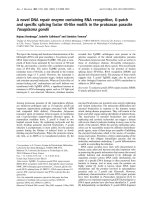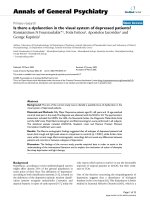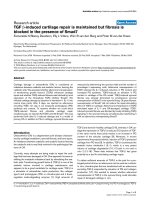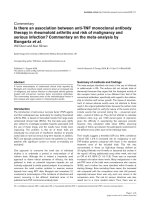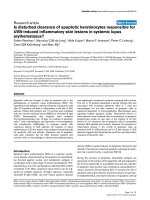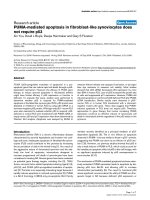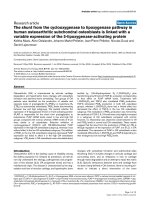Báo cáo y học: "Is mitral valve repair superior to replacement for chronic ischemic mitral regurgitation with left ventricular dysfunction" pps
Bạn đang xem bản rút gọn của tài liệu. Xem và tải ngay bản đầy đủ của tài liệu tại đây (591.41 KB, 9 trang )
RESEARC H ARTIC LE Open Access
Is mitral valve repair superior to replacement for
chronic ischemic mitral regurgitation with left
ventricular dysfunction?
Zhibing Qiu, Xin Chen
*
, Ming Xu, Yingshuo Jiang, Liqiong Xiao, LeLe Liu, Liming Wang
Abstract
Background: This study was undertaken to compare mitral valve repair and replacement as treatments for
ischemic mitral regurgitation (IMR) with left ventricular dysfunction (LVD). Specifically, we sought to determine
whether the choice of mitral valve procedure affected survival, and discover which patients were predicted to
benefit from mitral valve repair and which from replacement.
Methods: A total of 218 consecutive patients underwent either mitral valve repair (MVP, n = 112) or mitral valve
replacement (MVR, n = 106). We retrospectively reviewed the clinical material, operation methods,
echocardiography check during operation and follow-up. Patients details and follow-up outcomes were compared
using multivariate and Kaplan-Meier analyses.
Results: No statistical difference was found between the two groups in term of intraoperative data. Early mortality
was 3.2% (MVP 2.7% and MVR 3.8% ). At discharge, Left ventricular end-systolic and end-diastolic diameter and left
ventricular ejection fraction (LVEF) were improved more in the MVP group than MVR group (P < 0.05), however, in
follow-up no statistically significant difference was observed betw een the MVR and MVP group (P > 0.05). Follow-
up mitral regurgitation grade was significantly improved in the MVR group compared with the MVP group (P <
0.05). The Kaplan-Meier survival estimates at 1, 3, and 5 years were simlar between MVP and MVR group. Logistic
regression revealed poor survival was associated with old age(#75), preoperative renal insufficiency and low left
ventricular ejection fraction (< 30%).
Conclusion: Mitral valve repair is the procedure of choice in the majority of patients having surgery for severe
ischemic mitral regurgitation with left ventricular dysfunction. Early results of MVP treatment seem to be
satisfactory, but several lines of data indicate that mitral valve repair provided less long-term benefit than mitral
valve replacement in the LVD patients.
Background
Good-risk patients w ith ischemic mitral regurgitation
(IMR) also benefit from mitral valve repair (MVP)com-
pared with mitral valve replacement(MVR), with better
early and late (5-year) survival, in part because of pre-
servation of the subvalvar apparatus [1,2]. However, the
presence of significant MR in the presence of left ventri-
cular dysfunction (LVD) represents more advanced dis-
ease and is associated with a poor prognosis. There is
discrepancy in the literature regarding the benefit of
repair in IMR patients with LVD. In patients with LVD,
the use of MVP instead of MVR has been questioned,
with some centers reporting equivalent outcomes in
select patients [3,4].
The purpose of this investigation was to review our
experience of MVP versus MVR in LVD patients who
underwent concomitant cardiac procedures to determine
what differences, if any, exist in regard to morbidity and
mortality. In addition, long-term mortality after r epair
and replacement in LVD patients was compared.
Because selection of the valve repair or replacement
procedure was not randomized, comparison required (1)
to determine which patients were more likely to receive
valve repair rather than replacement a t this center,
* Correspondence:
Department of Cardiothoracic Surgery, Nanjing First Hospital affiliated to
Nanjing Medical University, Nanjing Heart Institute, Nanjing, China
Qiu et al. Journal of Cardiothoracic Surgery 2010, 5:107
/>© 2010 Qiu et al; licensee BioMed Central Ltd. This is an Open Access article distributed under the terms of the Creative Commons
Attribution Licens e ( nses/by/2.0), which pe rmits unrestricted use, distribution, and reproduction in
any medium, provided the original work is properly cited.
(2) to determine whether survival was better after mitral
valve repair or replacement, (3) to discover which
patients benefit from valve repair and which from
replacement.
Patients and methods
Patient Selection in the Study
Ischemic mitral valve disease was classified from analysis
of clinical information, operative reports, and echocar-
diograms. Thus all patients in this study had at least
one previous myocardial infarctio n. Mitral regur gitation
(MR) was defined as being ischemic in origin as evi-
denced by clinical data and echocardiographic findings.
Mitral leaflets were normal, associated regional wall
motion abnormality, and regurgitation was the result of
completed MI, which is always present in the history of
each patient [5,6]. Patients with functional IMR with
Carpentier type IIIb and type I disease [6] were included
in the study.
Data of 218 patients with significant chronic IMR who
underwentCABGcombinedwithmitralvalve(MV)
operations at a single institution from January 2001
through May 2009 were retrospectively analyzed. This
reference group included patients who underwent MV
repair (n = 112) and MV replacement (n = 106) during
the same period. All patients had grade 3/4 or 4/4 MR
on preoperative transthoracic echocardiography. Demo-
graphic and preoperative characteristics were shown in
Table 1 . Figure 1 showed trends in prevalences of both
types of MV surgery by calendar year. No statistical dif-
ference was found between the two groups in term of
the actual proportion of patients.
Exclusion criteria were mitral stenosis, aortic or tricus-
pid valve replacement, previous valve repair or r eplace-
ment, emergency operation and non-isch emic mitral
valve disease including degenerative, rheumatic, infective
and congenital heart disease. The study protocol was
approved by the i nstitutional review committee of the
Nanjing First Hospital. Patients gave informed consent.
Surgical and Associated Procedures
All the patients had a standard monitoring, including a
Swan Ganz catheter and transesophageal echocardiogra-
phy. All procedures were performed through sternotomy
by one surgeon (Dr. Xin Chen) during the study period.
Patients were placed on cardiopulmonary bypass (CPB)
using standard techniques. Dual venous cannulation was
performed directly. Myocardial protection was achieved
with a ntegrade and/or retrograde cold blood cardiople-
gia. When performed, coronary artery bypass graft
(CABG) or atrial ablation procedure was done before
the mitral procedure. Surgical approach was always
transseptal. In case of incomplete vision, the incision
was continued to reach the roof of the left atrium.
Table 1 Preoperative Data
Mitral
repair
Mitral
replacement
P
value
Total number of patients 112 106
Age>65 years 75 (66.9%) 77 (72.6%) NS
Age range (years) 70.6 ± 8.6 71.8 ± 10.8 NS
Female 40 (35.7%) 47 (44.3%) NS
Hypertension 81(72.3%) 79(74.5%) NS
Diabetes mellitus 33(29.5%) 34(32.1%) NS
Hyperlipidemia 80(71.4%) 61(57.5%) 0.032
Smoker 76(67.9%) 81(76.4%) NS
COPD 21(18.8%) 24(22.6%) NS
Pulmonary hypertension 38(33.9%) 31(29.2%) NS
Chronic renal insufficiency 8(7.1%) 6(5.7%) NS
Peripheral vascular 4(3.6%) 3(2.8%) NS
Cerebrovascular accident 3(2.7%) 2(1.9%) NS
Atrial fibrillation 31(27.7%) 28(26.4%) NS
Previous MI (<30 days) 12(10.7%) 10(9.4%) NS
Previous PCI 70(62.5%) 45(42.5%) 0.003
NYHA III-IV 59(52.7%) 52(49.1%) NS
LVEF <30% 22 (19.6%) 24 (22.6%) NS
Echocardiographic data
LVEF (%) 34.6 ± 5.5 35.1 ± 4.3 NS
LVEDD (mm) 66.29 ±
6.36
65.29 ± 6.36 NS
LVESD (mm) 50.21 ±
11.08
51.21 ± 11.08 NS
LAD(mm) 58.04 ±
17.26
57.86 ± 17.15 NS
SPAP(mmHg) 47.24 ±
14.31
48.01 ± 14.59 NS
Left main disease >50% 36(32.1%) 39(36.8%) NS
3-vessel disease 91(81.3%) 88(83.0%) NS
Carpentier classification [6],
n (%)
Ia 40(35.7%) 35(33.1%) NS
IIIb
72(64.3%) 71(66.9%) NS
Severe MR(+4), % (n) 69(61.6%) 72(67.9%) NS
COPD = chronic obstructive pulmonary disease; MI = myocardial infarction;
mod = moderate; PCI = percutaneous intervention; NYHA = New York Heart
Association; LVEF = left ventricular ejection fraction; LVEDD = left ventricular
end-diastolic diameter; LVESD = left ventricular end-systolic diameter; LAD =
left atrial diameter; SPAP = systolic pulmonary artery pressure; Left main
disease = left main coronary stenosis; 3-vessel disease = triple coronary
stenosis; MR = mitral regurgitation NS = not significant;
Figure 1 Yearly distribution of patients.
Qiu et al. Journal of Cardiothoracic Surgery 2010, 5:107
/>Page 2 of 9
Myocardial revascularization was perform ed first. The
mean number of bypassed vessels was 3.2 ± 1.0 in
patients having MVP and 3.5 ± 1. 2 in patients having
MVR (P = 0.125). An internal thoracic artery graft was
used for 93.8% of patients who underwent repair and
95.3% of those who unde rwent replacem ent (P =0.620).
Mitral annuloplasty always involved the posterior annu-
lus and both commissures, and it was obtained by
means of a suture annuloplasty. Multiple techniques
were employed to achieve valve repair: leaflet resection,
neo-chord insertion, chordal transfer and edge-to-edge
appr oxim ation. When t he MV was repla ced, only a part
of the ante rior leaflet was exci sed to preserve the integ-
rity of the subvalvular apparatus. Transesophageal echo-
cardiography (TEE) was used routinely during intra-
operative period. Before sternal closure, cold s aline was
injected to confirm competence of the repair and TEE
was performed to confirm satisfactory MV function.
Aortic cross-clamp time was 105 ± 42 minutes in the
mitral valve repair group and 98 ± 39 minutes in the
mitral valve replacement group (P = 0.158). Periopera-
tive patient characteristics are given in Table 2.
At the end of the procedure, all patients electively
received 5 μg·kg
-1
·min
-1
of dobutamine and either nitro-
glycerin or sodium nitroprusside according to arterial
resistance. Other inotropic agents, as well as an intra-
aortic balloon pump, were used when necessary.
Echocardiography
All the patients had a preoperative transthoracic echo-
cardiogram. The mitral annulus was identified as the
leaflet hinge point, and its size was measured in the api-
cal long axis, four- and two-chamber views at the end of
systole; the mean value was considered. The distance
between the points where the MV leaflets coapt and the
mitral annulus plane was measured at end-systole in the
four-chamber apical long axis view. Left ventricular end-
systolic diameter (LVESD), left ventricular end-diastolic
diameter (LVEDD), left atrial diameter (LAD) and systo-
lic pulmonary artery pre ssure (SPAP) were measured
from parasternal M-mode acquisitions, and left ventricu-
lar ejection fraction (LVEF) was calculated using the
biplane Simpson method [7].
Preoperative and postoperative echocardiographic data
were recorded. The presence and entity of MR were
evaluated by using colored areas of jet regurgitation and
jet-to-left atrium a rea ratios [8]. Based on echocardio-
grap hy, MR severity was graded as no or trivial regurgi-
tation (0), mild (1+), moderate (2+), moderate to severe
(3+), or s evere (4+). All patients had 3+ to 4+ before
surgery (mean 3.59 ± 0.40+).
Follow Up
Follow-up (FU)was achiev ed by direct telephone contact
with the patient, family, primary care ph ysic ian , or car-
diologist. All living patients or their relatives were
mailed a questionnaire that contained questions related
to the patient’s current health status, medication, cardiac
death, and any cardiac events during follow-up. Two
patients were lost to follow-up in MVP group, and three
patients were lost in MVR group. The mean duration of
follow-up was 48.1 ± 13.7 months (range, 2 to 96
Table 2 Operative Details and Associated Procedures
Mitral repair (n = 112) Mitral replacement (n = 106) P value
Valve repair techniquea
Triangular resection 60(53.6%)
Quadrangular resection 36(32.1%)
Neochord insertion 10(8.9%)
Chordal transfer 3(2.7%)
Edge-to-edge repair 3(2.7%)
Annuloplasty ring 112(100%)
Valve replacement
Hancock porcine 46(43.4%)
Carpentier-Edwards pericardial 20(18.9%)
St. Jude mechanical 22(20.7%)
Carbomedic mechanical 18(17.0%)
LV reconstruction 7(6.3%) 6(5.7%) 0.854
Atrial ablation/appendage ligation 29(25.9%) 24(22.6%) 0.576
Coronary artery bypass grafting 112(100%) 106(100%) 1.000
Number of bypassed vessels 3.2 ± 1.0 3.5 ± 1.2 0.125
internal thoracic artery graft 105(93.8%) 101(95.3%) 0.620
Cross-clamp time(min) 105 ± 42 98 ± 39 0.158
CPB time(min) 136 ± 50 129 ± 41 0.424
Qiu et al. Journal of Cardiothoracic Surgery 2010, 5:107
/>Page 3 of 9
months) and 50.2 ± 14.4 months (range, 3 to 98
months) in patients with MVP and MVR, respectively.
At that moment, when possible, a transthoracic echocar-
diogram was performed by our cardiologists.
The primary end-points were to evaluate early and
midterm survival, the New York Heart Association
(NYHA) functional class and echocardiographic modifi-
cations of left ventricle and the presence of any grade of
IMR. Cardiac death was defined as death cardiac related
or sudden death; cardiac event as the occurrence of at
least one of following event: acute myocardial infarction,
surgical or interventional reoperation.
Data Collection
Perioperative risk factors and demographics were deter-
minedfromthedatabaseandsupplementedbychart
review. Po stoperative data were collected f rom patients’
hospital charts. Echocardiographic data were collected
from patients’ charts and hospital records. The data
were supplemented by interviews with primary care phy-
sicians and cardiologists. Strate gies for surgical revascu-
larizati on and for choice of mitral prosthesis were at the
discretion of the surgeon. Mortality data were obtained
from chart review and review of death certificates.
Statistical Analysis
Results are expressed as mean ± standard deviation
unless otherwise indicated. Statistical analysis comparing
two independent groups was perfo rmed with unpaired
two-tailed Student’s t test for the means or c
2
test for
categorical variables. Logistic regression was used to
identify risk factors for survival. Kaplan-Meier survival
curve estimates were used to compare actuarial survival
rates between mitral repair and replaceme nt in LVD
patients. The SPSS 13.0 software (SPSS Inc, Chicago, IL)
was used. Probability values less than 0.05 were consid-
ered significant.
Variables examined by logistic regression analysis in
terms o f risk factors of the surgical procedure included
the following: age older than 65 years, preopera tive
chronic obstructive pulmonary disease, previous PCI,
preoperative stroke or transient ischemic attack, left
main disease, preoperative LVEF less than 30%, renal
dysfunction (serum creatinine>2.0 mg/dl), Mitral valve
repair and replacement [9].
Results
Baseline Characteristics
Table 1 summarizes the preoperative patient character-
istics. All patients had sym ptomatic CAD, 10.1% had
had a myocardial in farction within 30 da ys of the opera-
tion, and 50.9% had New York Heart Association class
III or IV symptoms of heart failure. The two groups
were similar in terms of age, gender, incidence of
diabetes mellitus, baseline NYHA class, baseline LVEF,
and number of vessel d isease. The MVP group had sig-
nificantly more patients with hyperlipidemia (MVP
71.4% versus MVR 57.5%, P = 0.032) and previous PCI
(MVP 62.5% versus MVR 42.5%, P = 0.003) at baseline.
This was not unexpected since the patients were not
randomized and the decision whether to repair or
replace the mitral valve was based at least in part on
these characteristics.
Intraoperative characteristics
ThetypeofmitralrepairisshowninTable2.AllMVP
patients had ring annuloplasty and the median size of
the annuloplasty ring used was 30 mm (range, 26 to 34
mm). Ten patients (8.9%) with neo -chord insertion, 3
patients (2.7%) with chordal transfer and 3 patients
(2.7%) with edge-to-edge valvuloplasty were adopted in
anterior leaflet prolapse. Among patients who had a
mitral valve replacement, 94 (88.7%) had preservation of
the posterior mitral leaflet with part excision of the
anterior leaflet, and 12 (11.3%) had bileaflet preserva-
tion. Among patients undergone mitral valve replace-
ment, 62.3% received bioprosthesis, and 37.7% received
mechanical valves. No statistical difference was found
between t he two groups in term of intraoperative d ata,
including CPB time, aortic cross-clamp time and num-
ber of bypass grafts (p>0.05).
Perioperative morbidity and mortality
Postoperative data with duration of mechanical ventila-
tion, ICU treatment, complications and hospital stay are
listedinTable3.Meanintensivecareunitstayand
mean hospital stay had no statistical difference between
the two groups. In 49 patients (22.5%) intra-aortic bal-
loon pump (IABP) was inserted, with 28 patients preo-
perative insertion and 21 postoperative insertion (MVP
20.5% versus MVR 24.5%, P = 0.480). Five patients (5%)
required operative re-exploration because of bleeding
(MVP 1.8% versus MVR 2.8%, P = 0.607). Seven patients
needed readmission in the ICU for acute respiratory
insufficiency(MVP 2.7% versus MVR 3.8%, P = 0.647).
Furthermore, Table 3 demonstrates no difference
between the two groups occurred in terms of acute
myocardial infarction (0.89% in MVP, 0.94% in MVR, P
= 0.969), cerebrovascular accident (1.8% in MVP, 2.8%
in MVR, P = 0.607), low output syndrome (16.1% in
MVP, 15.1% in MVR, P = 0.842), and Acute renal fail-
ure(4.5% in MVP, 3.8% in MVR, P = 0.798). No patients
required reoperation after an initial mitral valve replace-
ment. One patient needed to mitral valve replacement
in the repair group, due to endocarditis.
Seven patients died during the first 30 postoperative
days: two died as a result of low output syndrome, and
five were lost for non-cardiac causes (rupture of
Qiu et al. Journal of Cardiothoracic Surgery 2010, 5:107
/>Page 4 of 9
abdominal aneurysm, tracheal bleeding, and multi-organ
failure as a result of bleeding). Early mortality was 3.2%
(7 of 218 patients). Three of them had undergone MV
repair (2.7%) and four had undergone MV replacement
(3.8%; P = 0.647). Logistic regression did not show that
mitral repair or replacemen t would be significant risk
fact ors for early mortality accor ding to the risk ratio for
survival (p>0.05).
Follow up mortality and outcomes
Mean follow-up of the survivors was 49.6 ± 12.5
months, with 18 patients (8.5%) died, 6 of cardiac causes
(heart failure in 3, sudden death in 1, and acute MI in 2)
and 12 died of non-cardiac causes (cerebrovascular acci-
dent in 4, septicemia in 3, car accident in 2, acute
respiratory failure in 2, and renal failure in 1). Ten of
them (9.2%) had undergone MV repair and eight had
undergone MV replacement (7.8%). The cumulative sur-
vival rate for both groups, including in-hospital mortal-
ity, is shown in Figure 1. And no statistically significant
difference was found between the two groups.
At discharge, NYHA class in the MVP group
improved from 2.9 ± 1.0 to 1.5 ± 0.4, but in the MVR
group it i mproved from 2.8 ±0.7 to 2.3 ±0.7 (MVP ver-
sus MVR, p < 0.05, Table 4). At the last follow-up,
NYHA class III or greater was present in 21 (19.6%)
patients in the MVP group and in 11 (11.1%) patients in
the MVR group (MVP versus MVR, p < 0.05). There
was no hemorrhaging, thromboembolic complications,
or residual leakage or stenosis during follow-up.
Follow up echocardiographic evaluation
The last known echoca rdiogram was found in 98.2%
(107 of 109) of MVP group patients and 97.1% (99 of
102) of MVR group patients in follow up. At discharge,
LVEDD (p < 0.05), LVESD (p < 0.05) and LVEF (p <
0.05) were more decreased in the MVP group versus
that seen in the MVR group. However, follow-up left
ventricular reversal remodeling measured by change in
LVEDD (p < 0.05), LVESD (p < 0.05), and LVEF (p <
0.05) was sign ificant ly observed in the MVR group with
respect to baseline values, but no statistically significant
difference in left ventricular reversal remodeling was
observed in the MVP group (p>0.05). In the MVR
group we found an improvement in SPAP at follow-up
with respect to patients in the MVP group (p < 0.05)
and to baseline values (p < 0.05). Follow-up LAD chan-
ged from 57.86 ± 17.15 to 40.21 ± 9.05 mm in the MVR
group and from 58.04 ± 17.26 to 48.32 ± 9.34 mm (p <
0.05) in the MVP gr oup. Follow-up MR grade was si g-
nificantly improved in the MVR group compared with
the MVP group (p < 0.05). Data are presented in Table
4.
Is Survival Better After Mitral Valve Repair Than After
Replacement?
After accounting for postoperative deaths, survival
between repair and replacement in LVD patients was
similar (P > 0.05). During the follow-up period, no
patient in the MVR group required reoperation for his
or her MV. Kaplan-Meier survival estimates at 1, 3, and
5 years were 0.96, 0.89, and 0.73 in MVP group, and
0.95, 0.88, and 0.71 in MVR group (Figure 2). Ove rall
survival distributions was equivalent in LVD patients
undergoing repair versus replacement (P > 0.05).
Multiv ariate analysis on all patients was performed to
account for confounding factors and included clinically
relevant risk factors (Table 5). After logistic regression,
independent predictors of decreased survival was asso-
ciated with age of 75 years or older (odds ratio, 1.89;
p < 0.05) and highly associated with preoperative renal
insufficiency (odds ratio, 3.27; p < 0.01) and LVEF <
30% (odds ratio, 2.41; p < 0.01). Preoperative arrhyth-
mia, MV replacement, concomitant operations,
Table 3 Perioperative datas
Mitral repair(n = 112) Mitral replacement(n = 106) P value
In-hospital(< 30 day) mortality 3(2.7%) 4(3.8%) 0.647
AMI 1(0.89%) 1(0.94%) 0.969
CVA 2(1.8%) 3(2.8%) 0.607
LOS 18(16.1%) 16(15.1%) 0.842
IABP support 23(20.5%) 26(24.5%) 0.480
Acute renal failure 5(4.5%) 4(3.8%) 0.798
Acute respiratory failure 3(2.7%) 4(3.8%) 0.647
Bleeding (mL/12 h) 2(1.8%) 3(2.8%) 0.607
Sepsis or endocarditis 1(0.89%) 0 0.330
ICU stay (h) 3.6 ±0.8 3.9 ± 1.0 0.265
In-hospital stay (d) 18.0 ± 8.2 19.5 ± 9.1 0.313
AMI = acute myocardial infarction; CVA = cerebrovascular accident; LOS = low-output syndrome; IABP = intraaortic balloon pump; ICU = intensive care unit; MV =
mitral valve; NS = not significant.
Qiu et al. Journal of Cardiothoracic Surgery 2010, 5:107
/>Page 5 of 9
reoperation, and left main disease were not found to be
significant prognostic factors.
Discussion
Although the results of mitral repair for IMR have
improved over the last 20 years, until recently, surgical
correction of IMR in the setting of severe left ventricular
dysfunction was considered anathema. Bolling and col-
leagues [10] demonstrated that this approach was feasi-
ble and could be conducted with reasonably low
morbidity, using an undersized annuloplasty repair
effectively corrects MR in heart failure patients. Romano
and Bolling [11] have reported their observational
experience in more than 200 patients with se vere MR
and left ventricular ejection fraction < 0.20) with mitral
valve repair. The 1-, 2-, and 5-year actuarial survival
rates were 82%, 71%, and 52%, respectively. New York
Heart Association class improved fo r all patients and at
the 24-month follow-up; However, patients in NYHA
class IV with extreme left ventricular dysfunction have
Table 4 Follow-up Clinical and Echocardiographic Results
Mitral repair Mitral replacement
Preoperative
(n = 112)
At discharge
(n = 109)
Follow-up
(n = 107)
Preoperative
(n = 106)
At discharge
(n = 102)
Follow-up
(n = 99)
Follow-up duration
(month)
48.1 ± 13.7 50.2 ± 14.4
NYHA class (Mean ± SD) 2.9 ± 1.0 1.5 ± 0.4
a
1.9 ± 0.5
a
2.8 ± 1.0 2.3 ± 0.7
ab
1.6 ± 0.4
a
NYHA class III or greater
(n)
59(52.7%) 10(9.2%)
a
21(19.6%)
a
52(49.1%) 23(22.5%)
a
11(11.1%)
ac
LVEDD(mm) 66.29 ± 6.36 54.01 ± 5.15
a
49.01 ± 4.57
a
65.35 ± 6.29 62.14 ± 5.06
ab
50.22 ± 4.35
a
LVESD(mm) 50.21 ± 11.08 43.09 ± 8.54
a
39.12 ± 7.52* 51.12 ± 11.53 48.34 ± 8.02
ab
40.06 ± 7.76
a
LAD(mm) 58.04 ± 17.26 53.31 ± 15.03
a
48.32 ± 9.34
a
57.86 ± 17.15 54.02 ± 15.28
a
40.21 ± 8.05
ac
LVEF (%) 34.6 ± 5.5 45.3 ± 4.3
a
54.2 ± 3.1
a
35.1 ± 4.3 40.2 ± 4.9
ab
55.1 ± 3.6
a
SPAP(mmHg) 47.24 ± 14.31 40.43 ± 10.52
a
37.07 ± 8.26
a
48.01 ± 14.59 40.05 ± 10.12
a
31.24 ± 7.13
ac
Grade of MR (Mean ± SD) 3.57 ± 0.38 0.95 ± 0.36
a
1.30 ± 0.65
a
3.42 ± 0.35 0.15 ± 0.05
a
0.40 ± 0.10
ac
Carpentier classification
[6], n (%)
Ia MR 40(35.7%) 40(36.7%) 38(35.5%) 35(33.1%) 33(32.4%) 32(32.3%)
IIIb MR 72 (64.3%) 69(63.3%) 69(64.5%) 71(66.9%) 69(67.6%) 67(67.7%)
Compares with Preoperative
a
p < 0.05; significantly MVR versus MVP group at discharge
b
p < 0.05; MVR versus MVP group in follow-up
c
p < 0.05.
NYHA = New York Heart Association; LVEDD = left ventricular end-diastolic diameter; LVESD = left ventricular end-systolic diameter; LAD = left atrial diameter;
LVEF = left ventricular ejection fraction; SPAP = systolic pu lmonary artery pressure; MR = mitral regurgitation; SD = standard deviation.;
Figure 2 Long-term survival with mitral valve repair (blue line) versus replacement (green line) in LVD patients.
Qiu et al. Journal of Cardiothoracic Surgery 2010, 5:107
/>Page 6 of 9
poor survival, regardless of mitral valve procedure, and
present a contemporary surgical challenge [12]. The
cent ral questions pertinent to the treatment of ischemic
mitral insufficiency by repair or replacemen t techniques
include effectiveness, appropriateness, and long-term
benefits.
For Which Patients Is Repair or Replacement Appropriate?
Although the applicability of MVP is easily appreciated
in the subset of patients with chronic ischemia and
annular dilation, it is noteworthy th at 21.1% (46/218)of
the repairs in our series were done in cases of se vere
LVD (LVEF < 30%). These cases are challenging to the
surgeon because evaluation of the damage to the sub-
valvular apparatus may be difficult. Not only does struc-
tural damage (ruptured chordae or papillary muscle)
need to be readily discerned, but subtle, ongoing patho-
logic processes of the subvalvular apparatus must also
be accurately appraised. The few patients with valve
reconstruction who required reoperation did so within a
short period after the original operation. Although there
was a trend toward further re-intervention in the
patients with val ve repai r, this difference can be attribu-
ted mainly to the learning curve associated with recog-
nizing the extent of reconstruction in IMR. It is
important to note that in our series there were no late
valve-related deaths among patients undergoing further
mitral valve surgery.
Surgical techniques for mitral valve repair in patients
with ischemic mitral regurgitation have been described
by others [13,14]. Functional i schemic mitral regurgita-
tion was repaired by annuloplasty alone. We prefer to
use an undersized annuloplasty, and most of patients
who underwent mitral valve repair had an annuloplasty
that was 30 mm or smaller. Others have also reported
excellent results with an undersized a nnuloplasty for
functional ischemic mitral regurgitation [15]. In our
institution, we ha ve adopted Gore-Tex neo-chord, chor-
dal transfer or edge-to-edge valvuloplasty to use in ante-
rior leaflet prolapse without excess tissue.
However, the possibility of allowing both leaflets to
coapt depends on the ability of the anterior leaflet to
move toward the annulus and to reach the posterior
one. If this movement is insufficient, the mitral leaflets
never coapt no matter how much the posterior annulus
is reduced. For this reason, for each patient, we evaluate
the depth of the anterior leaflet during systole. Accord-
ing to our experience this value is crucial for deciding
whether to repair (if 10 mm or less) or to replace (if
more than 10 mm) the MV, which corresponds with
results of earlier reports [16]. Moreover, the 5-year
results appear to be similar to the results in patients
undergoing MV repair and replacement, although it is
likely that curves can diverge significantly with a longer
follow-up and a greater number of patients. This finding
focuses on preventing MR recurrence (or reducing it as
much as possible), which is the main target of MV sur-
gery for IMR.
Earlier reports have shown that use of preoperative
IABP therapy can reduce myoca rdial ischemia and
therefore improve outcome in high-risk patients under-
gone CABG with the use of CPB [17]. Recent re ports
have indicated that pre- and perioperative IABP therapy
facilitates manipulation of the heart with maintained
hemodynamic stability and with reduced myocardial
oxygen demand in high-risk patient s undergoing CABG
surgery [18]. In the study, there were 19 patients preo-
peratively inserted IABP and 10 patients postoperatively
IABP therapy.
Is Mitral Reconstruction an Effective Treatment Option?
Patients with IMR and LVD have an unfavorable prog-
nosis, with poor survival relative to patients with other
causes of mitral dysfunction [19,20]. It is therefore
important to determine which factors influence early
and late survival for risk stratification and alteration of
surgical approach that might i mprove survival. We
documented several risk factors for early and late death
after surgical treatment of ischemic mitral regurgitation.
These included such general factors as o lder age,
advanced NYHA functional class, severe left ventricu lar
dysfunction, and preoperative renal dysfunction.
An attempt to preserve the native MV apparatus to
maintain the normal shape, volume, and functi on of the
LV by reparative surgery is always preferred to valve
replacement. If successful, the risk of long-term anticoa-
gulation and prosthetic valve complications are also
avoided. Mitral valve repair leads to improved survival
as compared to MV replacement. Mitral valve
Table 5 Prognostic Factors for Survival
a
After Mitral
surgery for Ischemic Mitral Regurgitation
Prognostic Factors Survival
a
OR 95% CI p Value
Age > 65 years 1.89 1.01-2.86 0.012
Female 1.29 1.14-1.48 0.182
Preoperative renal insufficiency 3.27 1.52-4.64 0.003
COPD 0.99 0.81-1.23 0.221
Preoperative PCI 1.22 0.83-1.75 0.454
Previous stroke 1.35 0.67-2.81 0.323
left main disease 0.84 0.52-1.25 0.434
LVEF < 30% 2.41 1.30-3.15 0.002
Mitral valve replacement 1.27 0.78-2.14 0.630
Mitral valve repair 0.92 0.45-1.95 0.270
Reoperative procedure 1.00 0.87-1.17 0.945
a Multivariate Cox regression analysis of patients who survived >30 days. CI =
confidence interval; OR = odds ratio; COPD = chronic obstructive pulmonary
disease; LVEF = le ft ventricular ejection fraction.
Qiu et al. Journal of Cardiothoracic Surgery 2010, 5:107
/>Page 7 of 9
replacement with preservation of the subvalvular appa-
ratus gives significantly better results as compared to
MV replacement without preservation. Resection of the
entire subvalvular apparatus should almost never be
contemplated except in severely calcified valves.
Therefore, recent studies have reported that early
mortality of MVR is r educing, and is becoming similar
to MVP for patients with IMR and similar EF [21,22].
Our study shows that in a population of high risk
patients it is possible to achieve an acceptable and simi-
lar early mortality between MVP and MVR group.
Impact of MV Repair and Replacement on Ischemic MR
and LV Remodeling
In functional ischemic MR, the MV is structurally normal
and MR is caused by dysfunction of the LV, resulting in
incomplete leaflet closure [23]. We found that in patients
with functional recovery of the LV, the severity of MR and
LV size were significantly decreased after surgery, because
revascularization may improve LV dysfunction and geo-
metry, restoring valvular coaptation and thereby improv-
ing ischemic MR. At discharge, LVEDD, LVESD and
LVEF were more decreased in the MVP group versus that
seen in the MVR group. However, in follow-up reversal in
left ventricular remodeling measured by change in
LVEDD, LVESD, and LVEF was significantly observed in
the MVR group with respect to baseline values, but no sta-
tistically significant difference in left ventricular reversal
remodeling was observed in the MVP group.
LV reverse remodeling had been observed after
restrictive mitral annuloplasty, whereas the grade of MR
occurred higher after MVP than MVR, indicating that
LV remodeling might be a progressive vent ricular pro-
blem that cannot be t reated by a nnuloplasty. In an
experimental ovine model, prophylactic ventricular
restraint attenuated adverse remodeling and reduced
ischemic MR severity, whereas prevention of MR by
ring annuloplasty did not influence remodeling [24,25].
Previous clinical studies have compared t he re sults of MV
repair against those fol lowing MV re placement and have
concluded t hat preservation of the annular- chordal-papillary
muscle continuity res ults in maintenance of LV function
and geometry, leading to better patient outcome [21,26].
However, we could not observe a difference in outcome
between MV repair and replacement. One reason could be
the preservation of the mitral valve apparatus despite MV
replacemen t. But w e think that chor dal sparing mitr al valve
replacement i s not a better w ay to treat IMR because of the
need for anticoagulation for mechanical prosthesis in mitral
position and inevitable degeneration of b ioprosthesis.
What Are the Long-term Benefits?
Recent reports have successfully compared late results
with repair versus replacement for ischemic MR in a
statistically contro lled fashi on [21,27]. Both studies sug-
gested that MV repair may be better in low-risk
patients, but as expected the patient populations were
diverse. One study concluded that 70% of patients with
ischemic MR benefit from repair over replacement, but
in the high-risk setting, or with complex regurgitant
jets, survival were similar with both techniques [28]. In
the c urrent repor t, t he 5-year survival among the
patients with mitral repair and replacement in this series
ranged from approximately 71% to 73%. Gillinov and
associates [2] had 30-day mortality of 13% and, in the
lower-risk group, a 5-year survival of 58% after MV
repair and of 36% after MV replacement; in the higher
riskgroup,survivalaftereitherrepairorreplacement
was similarly poor. The authors concluded that even
though most pati ents with IMR benefit from MV repair,
in the most -complex, high-risk settings, survival after
either repair or replacement i s similar. And survival is
related to t he degree of impairment of LV, so this may
be the cause of lack of difference in survival betwe en
repair and replacement.
As recurrent MR after ring anuloplasty relates to LV
remodeling, approaches that also alleviate ventric ular
remodeling could potentially be part of a more compre-
hensive and effective management strategy for IMR [29].
Therefore, MV replaceme nt with intact subvalvular
appar atus should be considered in p atients with chronic
IMR who have multiple comorbidities, complex regurgi-
tant jets, or severe tethering of both mitral valve leaflets.
Limitations
This is a single-institu tion retrospective review, a limita-
tion to most of the liter ature comparing MV repair to
replacement. As such, there may be a selection bias for
valves that are able to be repaired. The repairability of a
valveincludingthecomplexityofvalvediseaseand
degree of annular calcification is difficult to assess by
reviewing operative notes of patients who underwent
mitral replacement and is a clear limitation to the
potential bias in our report. A standardized intraopera-
tive assessment model would be helpful in this and
future multicenter studies.
Finally, patients with intermittent ischem ic mitral
regurgitation treated by coronary revascularization alone
were not included in this analysis. Despite the limita-
tions, this study reaffirms the grave prognosis associated
with significant I MR and identifies predictors of early
and late death.
Conclusion
The efficacy of adding mitral valve repair to coronary
artery bypass grafting is well demonstrated by the
improvement of New York Heart Association functional
class and percentage of left ventricular ejection fraction
Qiu et al. Journal of Cardiothoracic Surgery 2010, 5:107
/>Page 8 of 9
and by t he decr ease of left ventricular end-di astolic dia-
meter, left ventricular end-s ystolic diameter, pulmonary
artery pressure, and left atrial size. Early results seem to
be satisfactory, even when most of these patients are in
preoperative congestive heart failure.
However, there is a perception that MV repair does
not provide long-term benefit in the most IMR patients
with LVD. When mitral valve repair is performed, a for-
mal annuloplasty should be used, and it is a beneficial
effect of preoperative IABP treatment in IMR patients
with LVD undergone MV surgery. At this end of the
spectrum, survival a nd freedom f rom mitral valv e reo-
peration were similar after repair and replacement,
whereas the grade of recurrent MR occurred higher
after MVP than MVR.
Acknowledgements
We thank all the participants of our hospitals for their tireless efforts to
ensure the timeliness, completeness, and accuracy of the registry data. This
study was supported by a grant from social development foundation of
Jiangsu province, China (BS2006013).
Authors’ contributions
QZB and CX had helped with design of the study, data interpretation and in
writing of the paper. XM has made the statistical analysis and took part in
the writing process. QZB also took part in the correction of the manuscript
according to the reviewers’ suggestions. JYS and WLM had helped in
gathering patient information and performed graphic measurements. XLQ
and LLL performed graphics and tables and added comments to the paper.
All authors read and approved the final manuscript.
Competing interests
The authors declare that they have no competing interests.
Received: 6 July 2010 Accepted: 8 November 2010
Published: 8 November 2010
References
1. Grossi EA, Goldberg JD, LaPietra A, Ye X, Zakow P, Sussman M, et al:
Ischemic mitral valve reconstruction and replacement: Comparison of
long-term survival and complications. The Journal of Thoracic and
Cardiovascular Surgery 2001, 22:1107-1124.
2. Gillinov AM, Wierup PN, Blackstone EH, Bishay ES, Cosgrove DM, White J,
et al: Is repair preferable to replacement for ischemic mitral
regurgitation? J Thorac Cardiovasc Surg 2001, 122:1125-1141.
3. Thourani VH, Weintraub WS, Guyton RA, Jones EL, Williams WH, Elkabbani S,
et al: Outcome and long term survival for patients undergoing mitral
valve repair versus replacement. Effect of age and concomitant coronary
artery bypass grafting. Circulation 2003, 108:298-304.
4. Shah AS, Hannish SA, Milano CA, Glower DD: Isolated Mitral Valve Repair
in Patients With Depressed Left Ventricular Function. Ann Thorac Surg
2005, 80:1309-1314.
5. Aronson D, Goldsher N, Zukermann R, Kapeliovich M, Lessick J, Mutlak D,
et al: Ischemic mitral regurgitation and risk of heart failure after
myocardial infarction. Arch Intern Med 2006, 166:2362-236 8.
6. Carpentier A: Cardiac valve surgery–the “French correction”. J Thorac
Cardiovasc Surg 1983, 86:323-337.
7. Kwan J, Shiota T, Agler DA, Popović ZB, Qin JX, Gillinov MA, et al:
Geometric differences of the mitral apparatus between ischemic and
dilated cardiomyopathy with significant mitral regurgitation real-time
three-dimensional echocardiography study. Circulation 2003,
107:1135-1140.
8. Helmecke F, Nanda NC, Hsiung MC, Soto B, Adey CK, Goyal RG, et al: Color
Doppler assessment of mitral regurgitation with orthogonal planes.
Circulation 1987, 75:175-183.
9. Akar AR, Doukas G, Szafranek A, Alexiou C, B oehm MC, Chin D, et al: Mitral valve
repair and revascularization for ischem ic mitral regurgitation: predictors o f
operative mortality and survival. JHeartValveDis2002, 11:793-800.
10. Bolling S, Smolens IA, Pagani FD: Surgical alternatives for heart failure. J
Heart Lung Transplant 2001, 20:729-733.
11. Romano MA, Bolling SF: Update on mitral repair in dilated
cardiomyopathy. J Card Surg 2004, 19:396-400.
12. Kouris N, Ikonomidis I, Kontoqianni D, Smith P, Nihoyannopoulos P: Mitral
valve repair versus replacement for isolated non-ischemic mitral
regurgitation in patients with preoperative left ventricular dysfunction. A
long-term follow-up echocardiography study. Eur J Echocardiography
2005, 6:435-442.
13. Margo W, Obriot P: Mitral valve repair. Aorn Journal 2007, 85:152-166.
14. Czer LS, Soukiasian HJ, De Robertis M, Magliato KE, Blanche C, et al:
Ischemic Mitral Regurgitation: Revascularization Alone Versus
Revascularization and Mitral Valve Repair. Ann Thorac Surg 2005,
79:1895-1901.
15. Braun J, van de Veire NR, Klautz RJ, Versteegh MI, Holman ER,
Westenberg JJ, et al: Restrictive mitral annuloplasty cures ischemic mitral
egurgitation and heart failure. Ann Thorac Surg 2008, 85:430-436.
16. Calafiore AM, Di Mauro M, Gallina S, Di Giammarco G, Iacò AL, Teodori G,
et al: Mitral valve surgery for chronic ischemic mitral regurgitation. Ann
Thorac Surg 2004, 77:1989-1997.
17. Christenson JT, Licker M, Kalangos A: The role of intra-aortic
counterpulsation in high risk OPCAB surgery: a prospective randomized
study. J Card Surg 2003, 18:286-294.
18. Suzuki T, Okabe M, Handa M, Yasuda F, Miyake Y: Usefulness of
preoperative intraaortic balloon pump therapy during off-pump
coronary artery bypass grafting in high-risk patients. Ann Thorac Surg
2004, 77:2056-2059.
19. Borger MA, Alam A, Murphy PM, Doenst T, David TE: Chronic ischemic
mitral regurgitation: repair, replace or rethink? Ann Thorac Surg 2006,
81:1153-1161.
20. Lamas GA, Mitchell GF, Flaker GC, Smith SC Jr, Gersh BJ, Basta L, et al:
Clinical significance of mitral regurgitation after acute myocardial
infarction. Survival and Ventricular Enlargement Investigators. Circulation
1997, 96:827-833.
21. Micovic S, Milacic P, Otasevic P, Tasic N, Boskovic S, Nezic D, et al:
Comparison of valve annuloplasty and replacement for ischemic mitral
valve incompetence. Heart Surg Forum 2008, 11:E340-345.
22. Jokinen JJ, Hippeläinen MJ, Pitkänen OA, Hartikainen JE: Mitral valve
replacement versus repair: propensity-adjusted survival and quality-of-
life analysis. Ann Thorac Surg 2007, 84:451-458.
23. McGee EC, Gillinov AM, Blackstone EH, Rajeswaran J, Cohen G, Najam F,
et al: Recurrent mitral regurgitation after annuloplasty for functional
ischemic mitral regurgitation. J Thorac Cardiovasc Surg 2004, 128:916-924.
24. Braun J, Bax JJ, Versteegh MI, Voigt PG, Holman ER, Klautz RJ, et al:
Preoperative left ventricular dimensions predict reverse remodeling
following restrictive mitral annuloplasty in ischemic mitral regurgitation.
Eur J Cardiothorac Surg 2005, 27:847-853.
25. Bax JJ, Braun J, Somer ST, Klautz R, Holman ER, Versteegh MI, et al:
Restrictive annuloplasty and coronary revascularization in ischemic
mitral regurgitation results in reverse left ventricular remodeling.
Circulation 2004, 110:103-108.
26. Thourani VH, Weintraub WS, Guyton RA, Jones EL, Williams WH, Elkabbani S,
et al: Outcome and long term survival for patients undergoing mitral
valve repair versus replacement. Effect of age and concomitant coronary
artery bypass grafting. Circulation 2003, 108:298-304.
27. Suri RM, Schaff HV, Dearani JA, Sundt TM, Daly RC, Mullany CJ, et al:
Survival advantage and improved durability of mitral repair for leaflet
prolapse subsets in the current era. Ann Thorac Surg 2006, 82:819-826.
28. Rukosujew A, Klotz S, Welp H, Bruch C, Ghezelbash F, Schmidt C, et al:
Surgery of secondary mitral insufficiency in patients with impaired left
ventricular function. J Cardiothorac Surg 2009, 17:36-40.
29. Al-Radi OO, Austin PC, Tu JV, David TE, Yau TM: Mitral repair versus
replacement for ischemic mitral regurgitation. Ann Thorac Surg 2005,
79:1260-1267.
doi:10.1186/1749-8090-5-107
Cite this article as: Qiu et al.: Is mitral valve repair superior to
replacement for chronic ischemic mitral regurgitation with left
ventricular dysfunction? Journal of Cardiothoracic Surgery 2010 5:107.
Qiu et al. Journal of Cardiothoracic Surgery 2010, 5:107
/>Page 9 of 9
